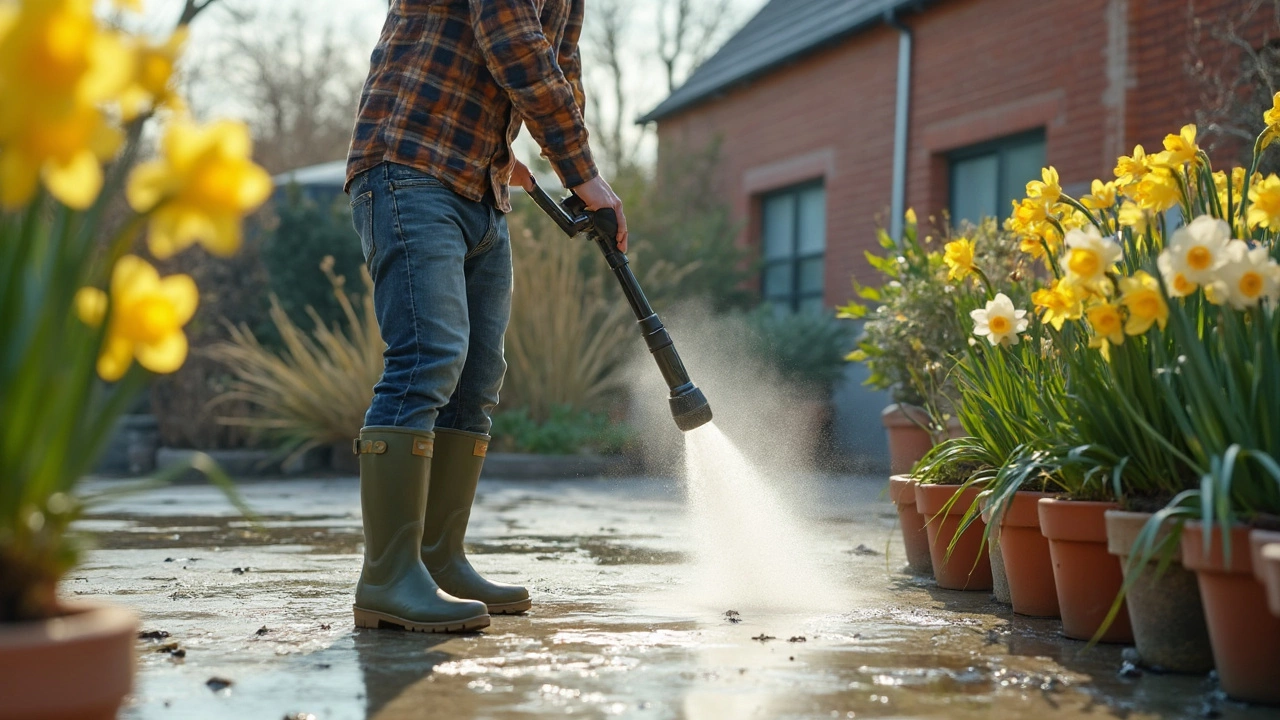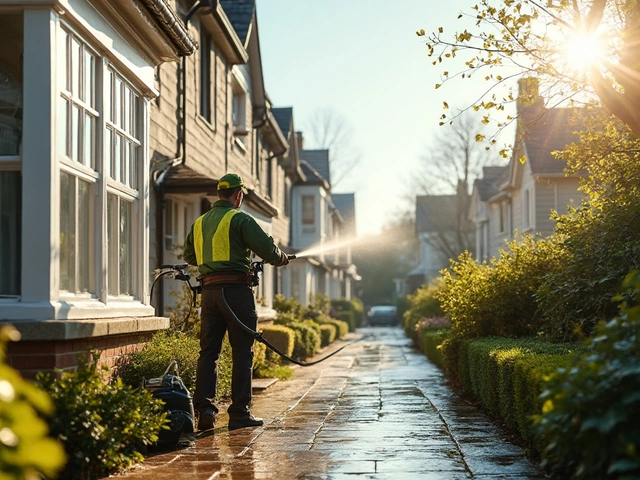Ever stared at your grimy concrete slab and wondered if that 2000 PSI pressure washer in the garage can do the trick? You’re not alone. A lot of folks think you need something industrial-grade to get real results, but 2000 PSI actually covers more ground than you’d expect—if you know what to do with it.
Pressure ratings can sound technical, but 2000 PSI is about the strength of a light-duty to medium-duty home machine. Imagine the power it takes to rip gum off a sidewalk or blast muddy paw prints away—2000 PSI is plenty for those jobs. It can tackle regular dirt, dust, food stains, and even some old oil marks if you work at it long enough. But if your slab has thick, stuck-on grease or vintage rust stains, you might hit a wall quick.
Before you fire up your washer, check the condition of your concrete. Freshly poured slabs can actually get damaged with too much force, while really old concrete can be tricky too since loose sections might break off. The nozzle you use makes a big difference—stick to a 15-degree or 25-degree tip for the sweet spot between cleaning power and safe coverage.
- What 2000 PSI Really Means
- What a 2000 PSI Washer Can and Can’t Clean
- Tips to Get the Most from 2000 PSI
- When to Upgrade for Tough Jobs
What 2000 PSI Really Means
Let’s cut through the numbers. When you see “2000 PSI” on a pressure washer box, that’s talking about “pounds per square inch”—the force the washer uses to push water out of the nozzle. For home owners, 2000 PSI sits right in the sweet spot: not too weak that you’re scrubbing forever, but not so strong you risk carving up your property.
To put it in perspective, garden hoses shoot out water at about 40 PSI. So, when you move up to a 2000 psi washer, you’re looking at 50 times more pressure. That’s why even a mid-range machine can blast away dirt that’s been sitting for years.
Here’s a quick look at how 2000 PSI compares to other common pressure washer ratings:
| Type | Pressure (PSI) | Common Uses |
|---|---|---|
| Garden Hose | 40 | Light rinsing, watering plants |
| Light-Duty Pressure Washer | 1300-1800 | Cars, bikes, patio furniture |
| Medium-Duty Pressure Washer | 2000-2800 | Fences, decks, driveways, concrete slabs |
| Heavy-Duty Pressure Washer | 2900+ | Paint stripping, big stains, commercial use |
According to Consumer Reports, “A 2,000 PSI pressure washer is more than enough for cleaning most outdoor home surfaces—including concrete walks and slabs—if you match it with the right nozzle.”
"Most homeowners will never need a pressure washer above 2000 PSI, unless they’re facing heavy industrial jobs or really stubborn stains." — Consumer Reports, Pressure Washer Buying Guide (2024)
Here’s what matters: 2000 PSI is the Goldilocks zone for most basic concrete cleaning. It’s powerful enough for mud, mildew, and faded spills. But it won’t knock out everything—sometimes it just needs some backup from detergents or a second pass. The greatest risk with higher PSI isn’t power, it’s damage; so with 2000, you’ve got a safety buffer. Always pick the right nozzle and keep the wand moving, and you’ll get strong results without gouging your concrete.
What a 2000 PSI Washer Can and Can’t Clean
So, what happens when you point a 2000 PSI washer at your concrete slab? You get pretty solid cleaning for everyday messes. This level of power is basically the sweet spot for most household cleanup jobs, but it does have its limits.
Here's what a 2000 PSI pressure washer can usually handle on a standard concrete slab:
- Dirt and dust build-up from outdoor exposure
- Mildew and algae patches that grow in shady areas
- Footprints, food spills, and fallen leaves
- Some fresh oil spots before they seep in
- Buildup from weather like mud, pollen, or grass stains
Now for the stuff where a 2000 PSI washer might let you down:
- Old or baked-in oil stains (they often need chemical pre-treatments)
- Thick layers of grease from cars or grills
- Deep rust stains that have been there for months or years
- Heavy moss or lichen growing in cracks
Why does this level have limits? It’s about contact time and penetration. A 2000 PSI spray breaks up basic grime but might not dig deep enough to lift stubborn, set-in stains. Professional-grade washers start at about 3000 PSI, which is more than 80% greater force, and pros often use heated water or special chemicals for hardcore stains.
| Type of Stain | Can 2000 PSI Remove? | Recommended Fix |
|---|---|---|
| Dirt/Dust | Yes | Direct spray |
| Mildew/Algae | Yes | Spray with a fan nozzle |
| Fresh Oil | Maybe (if treated quickly) | Degreaser and wash |
| Old Oil/Grease | No | Chemical treatment & higher PSI |
| Rust | No | Rust remover + scrubbing |
If you want a real-world take, pressure washing pro Lee Hartman says,
"A 2000 PSI washer is fine for general slab maintenance, but you'll need more grunt or the right chemicals for ground-in stains. People are often surprised what a difference pre-treating with the right product can make."
The key takeaway? For spring cleanups, mud, and household dirt, 2000 PSI usually gets it done. For heavy-duty garage stains, think about stepping it up—or get some muscle from cleaning solutions.

Tips to Get the Most from 2000 PSI
If you're trying to get your concrete slab as clean as possible with a 2000 PSI pressure washer, you need a game plan. The trick isn't just about having enough power—it's using it smartly. Let’s break down some practical tips and cool stats to make that grunt work actually pay off.
- Use the Right Nozzle: Stick with the 15° or 25° tip. The 0° nozzle looks powerful but can gouge your concrete or just make streaks. The wider 40° doesn’t have the punch for real cleanup. That sweet spot helps lift stains but protects your slab too.
- Pre-Treat Bad Stains: For oil or rust, soak the area with a concrete-safe cleaner. Let it sit for 10–15 minutes before blasting it. Hot water helps a ton, but not every 2000 PSI washer gives you that option, so at least use chemicals or hot tap water if your machine can handle it.
- Go Slow: Don’t rush it—cleaning in steady, slow passes gives the pressure enough dwell time to pull up grime. Try one to two feet per second for best results.
- Keep a Consistent Distance: Hold the wand about 6–12 inches from the slab. Too close, and you risk damaging the surface. Too far, and you lose cleaning muscle.
- Overlap Your Passes: Each swipe should overlap the last by about 50%. That avoids striping and missed zones, which is a super common letdown with home power washing.
- Safety First: Even at only 2000 PSI, it will cut through skin or shoes. Never point the wand at people, feet, pets, or breakables. Goggles are non-negotiable.
Curious what really makes a difference? Here’s a quick comparison of cleaning results with and without a few of these tricks, pulled from a popular home improvement review site:
| Approach | % Grime Removed (1 Pass) | Time to Clean 100 sq. ft. |
|---|---|---|
| 15° nozzle + pre-treat | 90% | 18 minutes |
| 25° nozzle, no pre-treat | 72% | 15 minutes |
| Improper nozzle (0°) | 60% + streaks | 25 minutes |
| No overlap/fast cleaning | 50% | 10 minutes |
You don’t always need more power—you just need to be smart and patient with the 2000 psi you’ve got. A little technique gets you a lot closer to pro results, even with a basic machine.
When to Upgrade for Tough Jobs
There are times when a basic machine just doesn’t cut it. If your concrete slab is caked with years-old oil stains, chewing gum that might as well be super glue, or that dreaded black mildew, 2000 PSI just won’t be enough. These situations call for more muscle—sometimes in the 3000 to 4000 PSI range. That kind of power isn’t just about speed; it’s about being able to break down things that ordinary pressure washers can’t touch.
If you’re trying to clean a commercial parking lot, remove old paint lines, or blast off thick layers of algae, a heavy-duty washer can save hours. Professionals often use models above 3000 PSI for a reason—it’s really the only way to get stubborn stains out of rough, textured surfaces without spending all day. Here’s a quick look at what higher-pressure machines offer:
| Pressure Level | Typical Use | What It Removes |
|---|---|---|
| 2000 PSI | Home patios, walkways | Dirt, dust, light stains |
| 3000 PSI | Driveways, dirty slabs | Medium oil, mildew, tough dirt |
| 4000 PSI | Commercial lots, prepping for painting | Paint, tough stains, stuck-on grime |
But don’t rush out and rent a monster machine unless your slab really needs it. Higher PSI can chip or etch soft or older concrete if you’re not careful. If you do decide to upgrade, here’s what to keep in mind:
- Wear eye and skin protection—a 4000 PSI stream can break skin.
- Test on a small corner first to avoid wrecking your slab.
- Use chemical cleaners made for concrete; they help loosen tough grime so even higher PSI works faster.
- If in doubt, ask a pro for advice, especially for old or cracked concrete.
Sometimes, just swapping your nozzle or using hot water on an existing machine makes a difference. But for really tough jobs, don’t be afraid to consider borrowing or renting a stronger pressure washer so your time and effort actually pay off.




